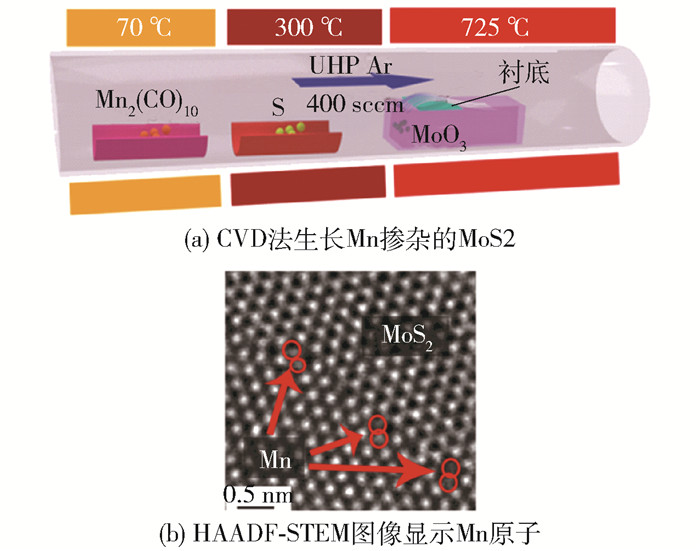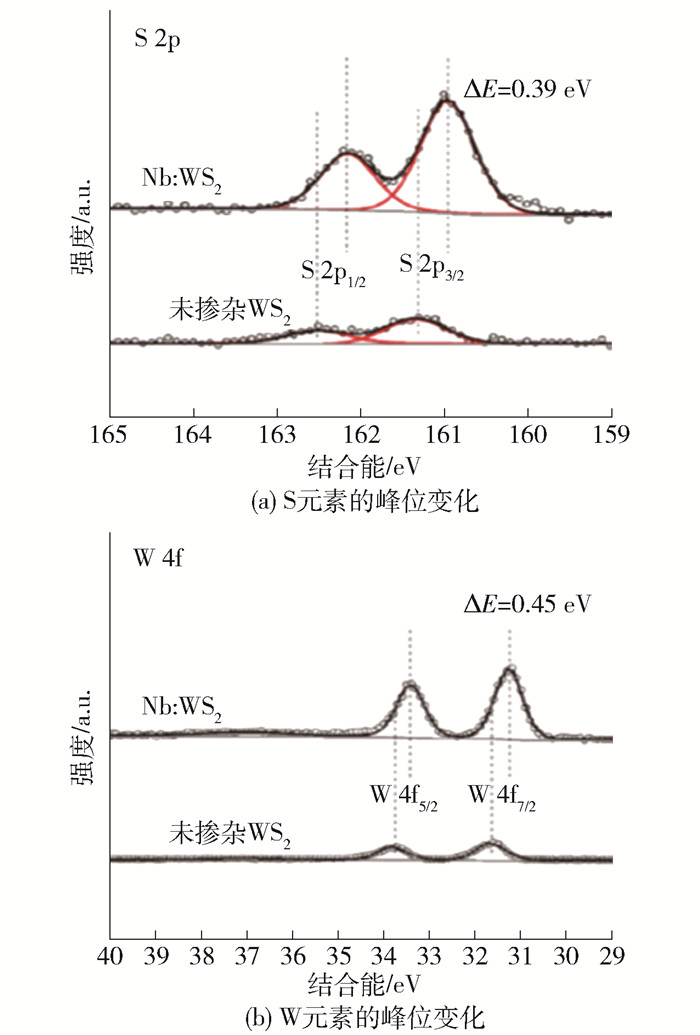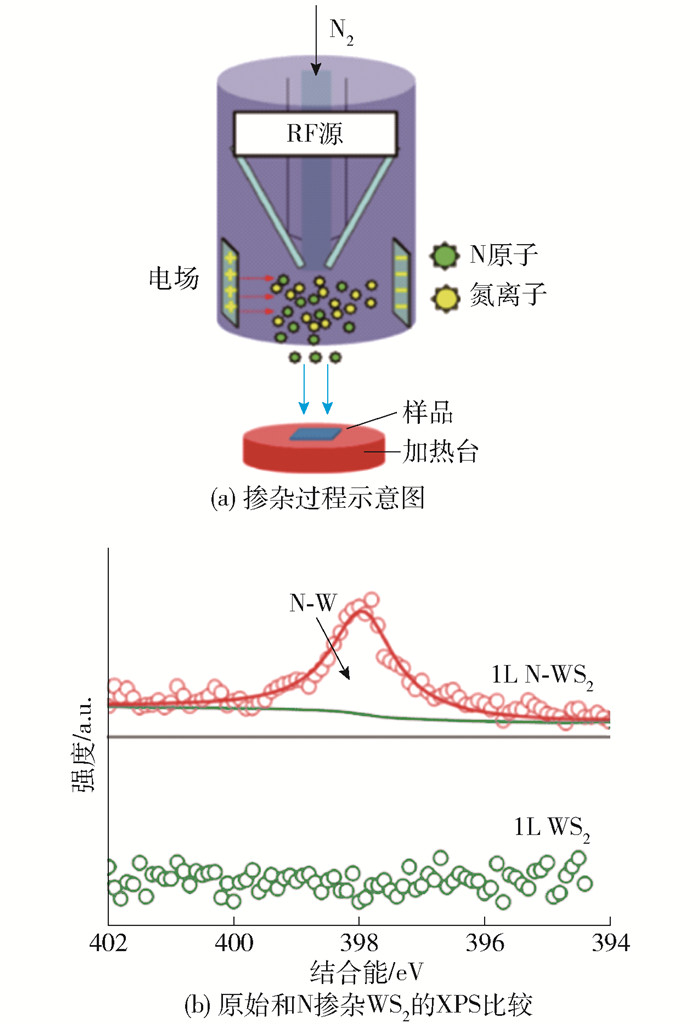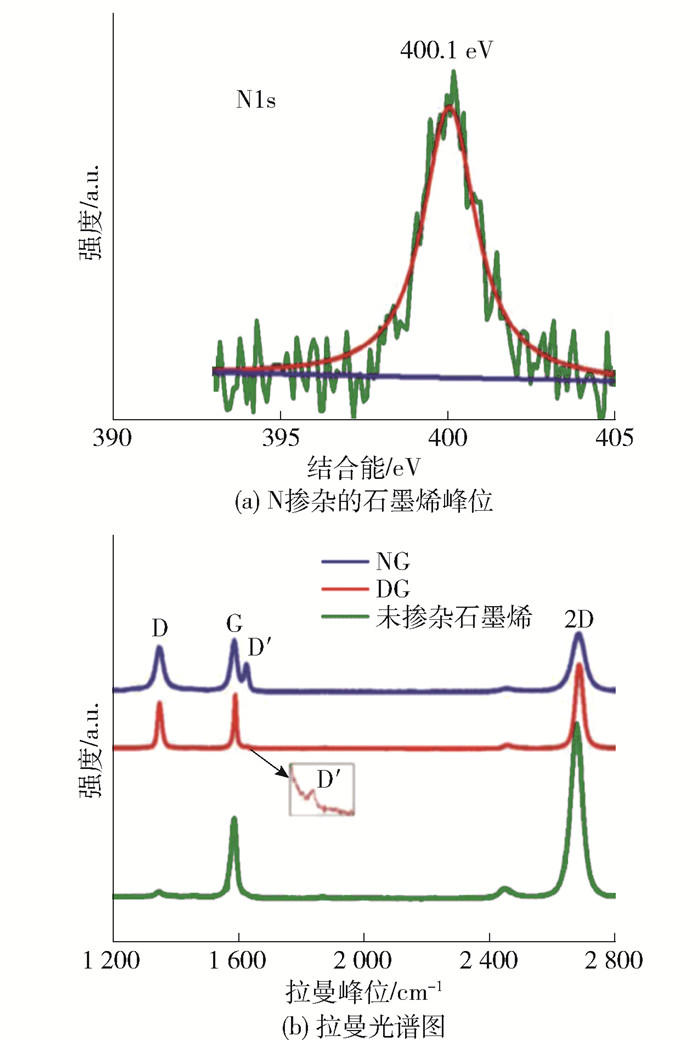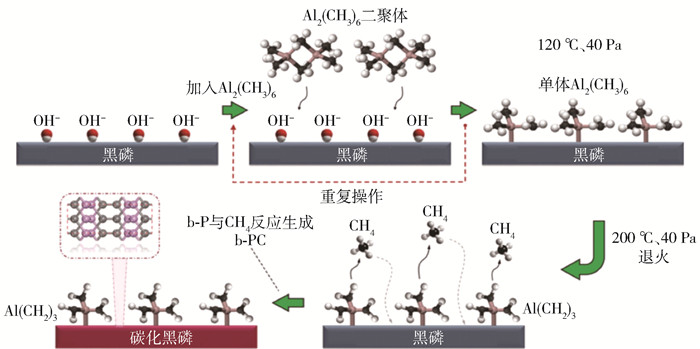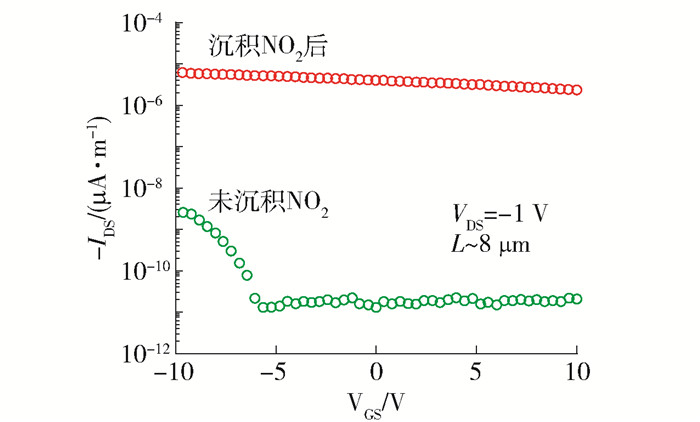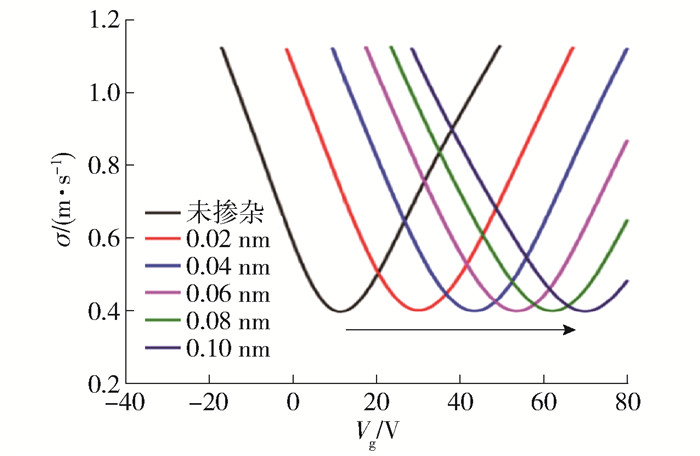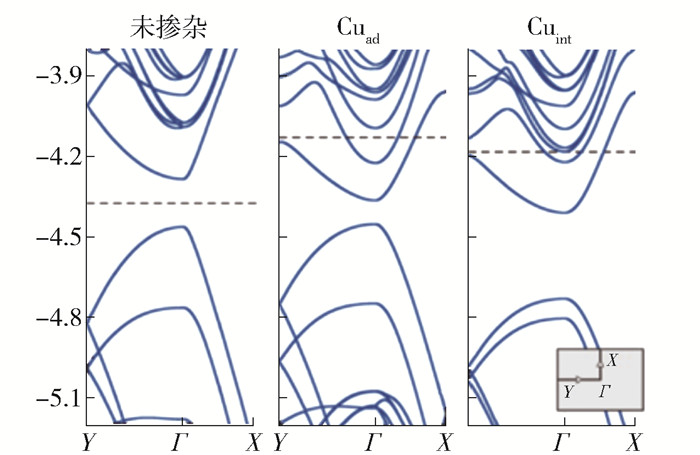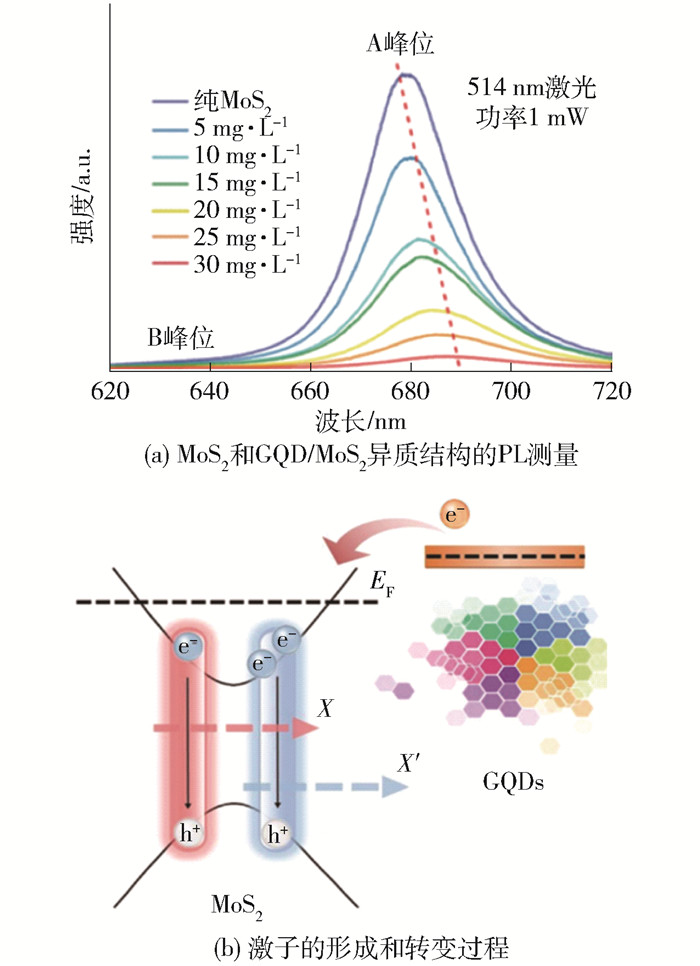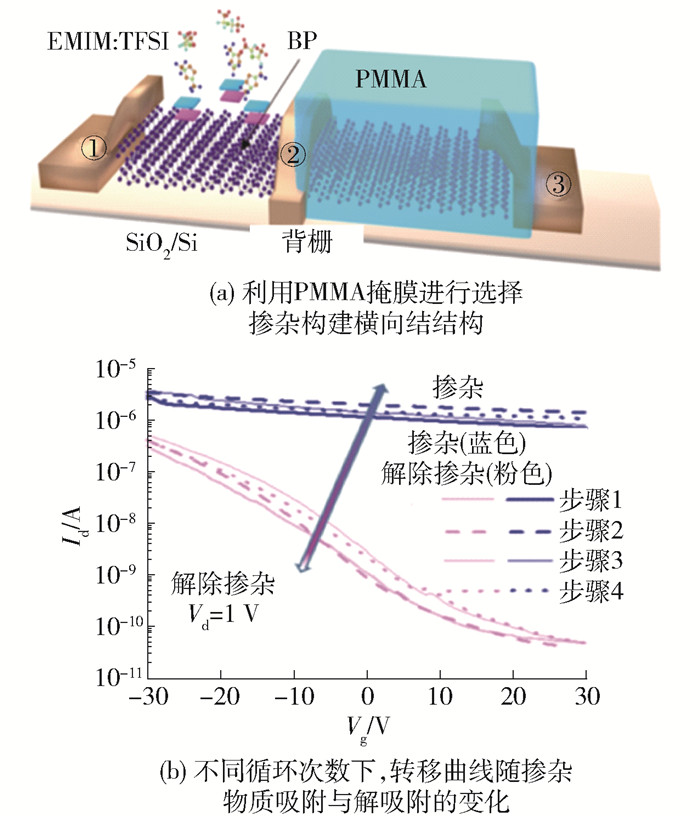Doping Methods and Their Influences on Two-dimensional Photoelectric Device Materials
-
摘要:
二维半导体材料如石墨烯、黑磷、过渡族金属硫化物, 因其尺寸小、易集成、光电性能优良等优点, 是现阶段微型化光电器件的良好沟道材料. 但材料存在不利于实际应用的一些缺点, 如石墨烯的“零带隙”、黑磷的易降解、过渡族金属硫化物本征迁移率低. 加之在器件制作过程中需要调节势垒高度, 因此通过掺杂来对二维半导体材料进行调节极为必要. 掺杂是通过引入杂质原子, 达到调节半导体材料的载流子类型和浓度、带隙、稳定性等目的. 对二维光电器件材料的主要掺杂方法、掺杂对材料微观结构和性能产生的影响进行了综述, 根据掺杂原子的占位情况分为位于原材料晶格中和表面两大类进行讨论. 在两大类中, 介绍了多种掺杂方法, 包括气相输运法、离子注入法、表面沉积法和化学旋涂法, 并讨论了每种方法的优点和局限性.
Abstract:Because of their small size, easy integration and excellent photoelectric properties, two-dimensional semiconductor materials, such as graphene, black phosphorus, and transition metal dichalcogenides, are good channel materials for miniaturized photoelectric devices. However, there are limitations in the application of two-dimensional semiconductor materials that remain to be resolved. These challenges include the "zero band gap" of graphene, the degradation of black phosphorus in water or oxygen, and the low intrinsic mobility of TMDCs. Additionally, barrier height needs to be adjusted in the process of device production. Hence, it is necessary to implement doping methods to adjust the two-dimensional semiconductor materials. By introducing impurity atoms, doping can influence carrier type, carrier concentration, band gap and stability of semiconductor materials. This paper reviewed recent researches on doping methods of two-dimensional photoelectric device materials, and how doping influences material structure and material performance. For the purpose of clarity, the methods were separated into two main categories based on location of the doped impurity atoms, either in the crystal lattice or on the material surface. Under each category, various doping methods were then introduced, including the vapor-phase transport method, the ion implantation method, the surface deposition method, and the chemical spin/drops method, and then the advantages and limitations of each method were discussed.
-
近年来,石墨烯[1-4]、黑磷[5-7]、过渡族金属硫族化合物[8-12]等二维半导体材料受到了广泛的关注. 二维半导体材料具有优良的电性能、适合的光学带隙,在纵向尺度上纳米级的尺寸则导致了其轻薄、比表面积大、良好的光学透性等一系列优点. 如石墨烯独特的二维蜂窝状结构导致其本征载流子迁移率可以达到极高的200000cm2·V-1·s-1,并且还具有高强度、良好的延展性等一系列优点. 黑磷和过渡族金属硫族化物是继石墨烯之后兴起的类石墨烯材料[13]. 黑磷具有高各向异性,可以制作偏振探测器[14],通过层数调控的带隙(0.15~2.20eV)可以吸收从近红外到可见光的宽范围[15-16]. 过渡族金属硫族化物具有极丰富的元素组成,进而衍生出不同的性能. 综合上述优点,这些二维材料已经成为光电器件的优异候选材料[17-18].
然而,二维材料也存在一些本征和性能上的缺点需要改善和克服. 与其他金属或半导体材料相比,石墨烯是一种零带隙半金属材料,不能实现半导体材料所具有的“逻辑开关”功能,需要打开带隙[19-20];黑磷在水氧环境中极易降解[21];二硫化钼(MoS2)的本征迁移率较低[22]. 而且,因为半导体与金属的能带结构存在差异,在制作器件产生接触时会产生较大肖特基势垒,所以仅使用低功函数的接触金属很难与材料形成低的接触电阻[23]. 如MoS2中的固有缺陷就导致了与接触金属功函数无关的肖特基势垒. 上述缺点限制了二维材料在光电器件领域的发展,最佳的改善方法是掺杂.
掺杂是把新的杂质元素引入材料内部或者置于表面. 这些被引入的具有电活性的杂质元素,可以作为电子供体或受体提供载流子,调节载流子类型,从而调节半导体材料的p/n型[24],提高载流子迁移率,从而实现材料导电性能的提高[25];也可以作为电子载体调节电子结构和能带结构[26],对不同波长的光产生吸收或减小肖特基势垒[27];而且可以通过改变晶体结构来提高材料的稳定性或黏附性[21],如石墨烯中掺杂诱导的电荷密度调制影响其润湿性和附着力[28]. 所以,掺杂作为半导体光电材料应用中最重要的环节,需要加倍重视和研究. 本文综述了近些年二维光电器件材料的掺杂方法,以及掺杂对材料产生结构和性能的影响. 以掺杂后杂质原子位于晶格中和材料表面分为两大类,又根据不同操作方法细分进行了讨论.
1. 掺杂元素位于原材料晶格中的掺杂方法
此类掺杂方法涉及到常用的取代(替位)、间隙原子、层间插入等掺杂原子进入原材料内部的机制. 一般通过气相掺杂法、注入掺杂法、高温高压法等,使掺杂元素通过高温扩散、电场力加速等进入晶格,起到供应载流子、调节带隙等作用. 在表征手段上,除了观察光电器件的转移曲线、输出曲线,推算迁移率等器件性能会随着掺杂改变以外. 还可以使用拉曼(Raman)光谱仪,X射线衍射仪(X-ray diffraction,XRD),透射电子显微镜(transmission electron microscope, TEM)等表征掺杂成功与否. 从表征结果来看,包括拉曼峰位移动、块体材料的XRD衍射峰变化、高分辨原子像中掺杂原子分布等,都可以表征是否成功掺杂.
1.1 气相掺杂(转移、沉积)法
气相掺杂法,利用高温使原料在热端气化,通过气相扩散充分混合,最后在冷端凝结生长出掺杂的材料.
以黑磷为主的磷系二维材料,通常应用气相转移法(chemical vapor transport, CVT)制备,把原材料先真空封管,再双温区加热生长,可以直接从源头加入掺杂物在生长过程中实现掺杂. Xu等[29]用此方法获得了掺杂硒(Se)的黑磷. 首先,把红磷、硒粉和矿化剂锡、碘化锡封入石英管内抽真空. 然后,将封装后的石英管在管式炉内加热到750℃并保温1h,在7.5h内冷却到500℃再保温3h,并且在8h内缓慢冷却至150℃. 最后,随炉冷却至室温. 在石英玻璃管的冷端可以得到掺Se的黑磷晶体. 如图 1(a)的掺Se黑磷拉曼光谱表征结果中,可以观察到因为掺杂出现的2个新峰,峰位分别为192、229cm-1. 与243cm-1处的Se峰不同,这是P-Se相的峰,并且该峰的强度随着掺杂浓度的上升增强. X射线光电子能谱(X-ray photoelectron spectroscopy, XPS)的结果进一步印证了黑磷中出现了掺杂峰. 通过第一性原理计算,O、S、Se掺杂会导致其费米能级向导带移动[30],降低肖特基势垒,掺杂Se的黑磷从单层0.3eV的间接带隙改变为0.4eV的间接带隙[31]. 因此,光激发产生的空穴就更容易穿过肖特基势垒,从而降低接触电阻. Se掺杂的黑磷制作光电探测器后,黑磷沟道和金属电极之间传输的电子增多. 图 1(b)为掺Se黑磷的转移特性曲线,右上角的小图为取对数后的结果,表现出黑磷的双极特性. 开/关电流比高达105,空穴迁移率提高为561cm2·V-1·s-1. 二维掺Se黑磷光探测器的响应率和外量子效率分别提高到15.33A·W-1和2993%,掺杂导致的带隙变窄、势垒降低是使黑磷的迁移率等性能提升的主要原因. 通过仿真模拟,Jalaei等[31]发现掺杂Se后的黑磷光电探测器能达到0.75μA·W-1的光电响应速度.
Liu等[32]用同一主族的砷(As)原子成功置换黑磷中的部分P原子得到黑砷磷(b-AsP). 与黑磷掺Se的方法基本相同,利用矿化剂辅助的短程气相输运反应,合成了成分可调的层状b-AsP材料. 与Xu等[29]的研究区别在于:此方法以置换的方式为主,掺杂元素不仅作为杂质存在,而且通过改变砷磷比来达到调节性能的目的. 对不同砷磷配比黑砷磷进行红外吸收测量,结果如图 2(a)所示,吸收边随着As元素掺杂量的增加向波数小的方向移动,在As原子分数为83%时达到约为1250cm-1的最小值.
结合图中数据,通过公式计算(Eg=hc/λ=1240/λ)得出带隙大约为0.15eV,为块体黑磷带隙(0.3eV)的一半,达到了远红外(far infrared radiation, FIR)吸收区域[14]. XRD图谱显示,掺杂后的块体黑磷所有峰位都向小角度偏移,这说明晶面间距d变大,掺杂是成功的. 根据置换原子含量不同,黑砷磷各组分的拉曼峰位存在显著的差异,大致分为低、中、高3种振动频率,如图 2(b)所示. 在砷原子置换磷原子过程中,化学键逐渐从P—P键转向P—As键,最后到As—As键. 拉曼峰位逐渐由高频区向低频区位移,说明As原子置换使黑磷的拉曼峰发生红移. 黑砷磷同黑磷一样,在偏振光的作用下,具有明显的拉曼强度变化,表明黑磷的各向异性结构被保留了下来. Liu等[33]用相似的方法,区别在于不使用双温区输运生长,而使用单温区均匀温度生长,也获得了高质量的块体黑磷,并成功实现多种元素的掺杂. Baumer等[34]用相似气相转移法,制得锑(Te)掺杂的紫磷. Te原子占据了2个P原子的位置,导致替位区域的P—Te键长增长,带隙为1.67eV. 制备出的FET器件迁移率为58.96cm2·V-1·s-1,开关比为103.
气相沉积法(chemical vapor deposition, CVD)是一种很常见的二维材料生长和掺杂的手段,常应用于石墨烯[35]、过渡族金属硫化物等的掺杂. Zhang等[36]运用CVD法制得了Mn掺杂的MoS2,并研究了衬底对于掺杂的影响. 如图 3(a)所示,2mg的MoO3在管式炉的末端高温区,3种衬底(蓝宝石、SiO2、石墨烯)面朝下放置在MoO3粉末上方,以确保MoO3蒸气最大限度地与衬底表面接触;700mg S粉和0.1mg Mn2(CO)10粉(Mn/Mo前驱体比1∶50)置于管式炉前端中温区和低温区. 高温区、中温区和低温区的温度分别设置为725、300和70℃,并向管式炉持续输送氩气. Mn和S气化后被输送至管式炉末端,最后得到Mn掺杂的MoS2.
如图 3(b)所示,采用高角度环形暗场扫描透射电镜(high angle angular dark field-scanning transmission electron microscopy, HAADF-STEM),可以通过不同的衬度直观地观察到掺入的Mn原子. 通过更换不同的衬底,Zhang等发现在惰性衬底(如石墨烯)上生长,可以在MoS2中掺入几个百分比的Mn,而在具有活性表面的衬底(如SiO2和蓝宝石)上生长,Mn的掺入被抑制,只导致了MoS2产生缺陷.
采用相似的方法,研究人员把Mn2(CO)10粉换成稀土元素Re,得到Re取代量为1%的MoS2[37]. Chang等在WS2中掺Sn[38],首先使WS2在高温下产生热硫空位,随后掺杂物质SnS前驱体中的S原子会占据此S空位,而Sn原子则变成悬挂原子,并置换出临近的W原子形成掺杂. Iacovella等[39]的研究表明:利用CVD退火和升温掺杂产生硫空位也是很好的空位掺杂手段,可使MoS2或WS2形成n型空位掺杂.
Qin等[40]使用液态前驱体CVD法制得铌(Nb)掺杂的WS2. 在氩气气氛中,将液态前驱体滴落在Si/SiO2衬底上,前驱体与硫蒸气反应,实现掺杂生长. 优化初始混合物的浓度,掺杂浓度可以高达到1014cm-2(>10%Nb). 随着Nb浓度的增加,WS2出现空穴导电性,这说明Nb掺杂剂在室温下是电离受体. 场效应晶体管(field effect transistor, FET)的室温传输特性也表明存在明显的空穴掺杂. 如图 4所示,XPS结果表明,峰位均向着低能量的方向移动,掺Nb的WS2结合能降低,p型电导率增强.
气相掺杂法能否实现的关键是原材料元素与掺杂元素能否结合. 一般通过第一性原理计算等方法来预测是否可以成功实现掺杂,计算的结果对实验有很好的指导性. Huang等[41]报道了SnSe2的掺杂计算结果,金属元素具有较大的正取代能和深跃迁能级而被排除在有效掺杂源之外. 而且,P和As可以将陷阱态引入带隙中,所以N/P/As掺杂并不能有效地获得具有p型电导率的SnSe2单分子层. Br是最好的n型掺杂候选材料. 从计算结果来看,它在富Sn条件下具有负取代能,并能引入低施主能级. 另外一方面,对于等电子掺杂(如掺杂O、S、Te等),SnSe2单层半导体特性没有改变,杂质对能带边缘附近态的贡献随着原子序数的增加而增加. Kim等[42]计算了少层黑磷的K元素掺杂效应,预测了黑磷能带结构与掺杂浓度的关系,并通过原位掺杂技术成功实现.
气相法掺杂,掺杂元素主要是同族或相邻族的元素,通过材料的重新生长或者以形成结合键的形式,使掺杂元素稳定存在于材料中. 但是,掺杂过程难以实现,首先需要通过理论计算预测,通常还需要多次调节实验参数来达到预期掺杂效果,研究周期长、难度大. 但相对于其他掺杂方法,气相转移法掺杂的材料结晶性最好,性能相对来说也最稳定.
1.2 注入掺杂法
注入掺杂,使用辉光放电等多种方法,将掺杂的原子或分子离化,转变成带电粒子. 带电粒子在电场中获得动能并加速,轰击材料表面,使掺杂元素进入晶格,来实现掺杂并改变材料的性能.
Nipane等[43]实现了在MoS2中掺杂P. 电感耦合等离子体(inductively coupled plasma,ICP)源将P原子离化,产生低能量高密度磷等离子体[44],在脉冲直流偏压(振幅为0~2keV)作用下,磷等离子体轰击MoS2实现掺杂. 在这个过程中,通过改变接通时间、周期可以控制掺杂浓度和深度. 选用脉冲偏置电压要比连续偏置电压的掺杂效果更好,这是因为脉冲偏置电压对样品造成的损伤小,而且可以抵消在样品上积累的部分多余电荷.
Tang等[45]用氮原子对WS2进行掺杂,在Nipane方法[43]的基础上增加了筛选的步骤. 如图 5(a)所示,从射频源溅射的氮离子和N原子通过等离子约束板时,高能的电离氮离子在外加电场作用下发生偏转,从而被保留在腔体内,这就是筛选过程.
而N原子不发生偏转掺入WS2,其低动能对材料表面损伤很小. 在掺杂N的单层或多层WS2中,N的引入导致费米能级附近产生缺陷态,所以在价带顶上的0.24eV处会产生一个较浅的受主能级. 如图 5(b)所示的XPS测试结果显示,掺杂后的WS2在398eV处出现了N与W的结合峰. 同Qin[40]的研究一致,随着掺杂浓度的增加XPS峰发生偏移,N-WS2的峰向结合能较低的方向移动,这意味着材料的费米能级向价带顶移动,实现了p型掺杂. Pierucci等[46]使用注入法在MoS2中掺杂H元素,可以把MoS2从本征n型半导体调节到p型半导体. 同时,H掺杂也可以填充MoS2中硫空位直至饱和.
Zafar等[47]实现了在石墨烯中掺杂N元素. 石墨烯中N元素掺杂通常有3种键合构型,即:吡啶基N(398.1~399.3eV),吡咯基N(399.8~401eV)和四价N也称为石墨态N(401.1~402.7eV)[48]. 图 6(a)的XPS结果显示掺杂后石墨烯中单个洛伦兹离子N 1s峰位于400eV,表明键合构型为吡咯氮,这可能与含H2的生长、掺杂条件有关. 图 6(b)的拉曼结果显示,G峰(约1580cm-1)和2D峰(约2675cm-1)为石墨烯的特征峰,NG(N掺杂的石墨烯)和DG(通过氩离子轰击的缺陷石墨烯)在约1348cm-1处还存在一个强D峰,该D峰是由缺陷产生的. NG和DG还观测到一个位于约1620cm-1的额外峰(D′峰),它来自于双共振散射过程,也是与离子轰击产生的缺陷相关. NG中G和2D峰的蓝移是由掺杂后电子结构变化和压缩应变共同作用的结果.
通过用例如聚甲基丙烯酸甲酯(polymethyl methacrylate, PMMA)的掩膜材料,对光电器件进行掩膜掺杂,未掺杂区通过掩膜保护,与掺杂区构建不同的结区,可以制作各种光电器件. Kim等[49]就用掩膜的等离子体注入掺杂,制作硼掺杂的黑磷p-n结. 而且报道了脉冲等离子体的注入方法,成功抑制了黑磷氧化态的形成. Lu等[50]也通过等离子体选择型掺杂制备了同质结构成不同的器件结构.
作为传统的掺杂方法之一,注入掺杂相对于气相转移法的操作要容易很多,但对设备的要求相对高一些. 掺杂元素是通过外部后期注入,杂质在样品同深度下横向分布较均匀、剂量可控、纯度高,掺杂过程可以在常温或者低温环境中操作;而且,作为光电器件制作中较为主要的掺杂方法,它可以用例如光刻胶等作为掩膜,制备同质结,同时可以对异质结、接触触点等位置实现精确掺杂. 但离子注入的缺点也很明显,如掺杂后材料会产生缺陷,甚至非晶化,即使采用退火处理也并不能完全消除离子注入对晶格的破坏,而且可能会使掺杂元素在高温条件下产生重新分布,破坏掺杂效果.
1.3 其他掺入晶格的掺杂方法
1) 高温高压法:Yang等[21]通过高温高压的方法合成了碲(Te)掺杂的黑磷. 将红磷和碲粉混合,压制成直径和高度均为6mm的圆柱体. 将混合后的圆柱体放入外径为8mm的氮化硼坩埚,然后再插入内径8mm、外径10mm的石墨加热坩埚,最后放入叶蜡石载体中,石墨坩埚通过穿过叶蜡石载体的氧化锆管加热. 在六面顶压机中,叶蜡石立方体既是传压介质又是垫片. 在2GPa和1000℃的条件下,反应10min. 在高温高压下,掺杂元素通过热扩散机制,渗入晶格. 掺杂后的黑磷,拉曼峰向低波数的方向移动,扫描mapping显示出均匀的掺杂,FET器件迁移率可以达到1850cm2·V-1·s-1. 最为重要的是掺杂成功抑制了黑磷在大气环境中易与水氧发生降解的反应,保证了器件长期稳定.
如图 7所示,暴露在大气环境1周后的原子力显微镜图像显示,未掺杂的样品完全失效,而掺杂样品在1个月后还保持完整形貌. 核磁共振结果显示,相比于未掺杂的样品,掺杂样品并未出现较强的磷酸、亚磷酸峰. 暴露在大气环境3周后,Te掺杂的器件保留了50%的初始电流特性,而未掺杂的器件接近完全失效,通电电流大大降低到初始值的2%. 掺杂后黑磷的抗降解能力也明显地反映在随着暴露时间的增加,迁移率和开关比降低要慢得多.
Lü等[51]采用相同的高压方法又掺杂了S元素,也成功抑制了黑磷的降解. 结合2篇文献分析,因为黑磷降解是磷与氧的接触形成PxOy,再与水接触会形成磷酸、亚磷酸,进而导致下层的磷继续与氧发生反应. 掺杂能抑制磷与氧的反应进而减缓降解的发生,高压黑磷的掺杂元素会有偏聚,抗降解效果更好. Zhang等[52]用气相输运的方法也合成了Te掺杂黑磷,但是该晶体并不具有环境稳定性,说明降解的问题还有待深入研究. Wang等[53]通过计算模拟研究了过渡族金属钪(Sc)的黑磷掺杂,研究结果表明,掺杂Sc原子吸附在黑磷上与3个P原子成键,导带底的位置变为-4.18eV,低于O2/O2-的氧化还原电位(-4.11eV),掺杂可以抑制降解.
2) 化学反应置换:最早研究人员通过对金刚石的磷掺杂,合成了块体碳化磷[54],后又通过磁控溅射和激光脉冲沉积等手段制备了碳化磷[55-56]. Tan等[57]采用表面化学反应的方法制备了碳化黑磷(b-PC).如图 8所示,首先把机械剥离的黑磷移入原子层沉积(atomic layer deposition, ALD)室. 采用三甲基铝(trimethylaluminium, TMA)前驱体在120℃的衬底温度和40Pa的室压下对黑磷进行反复脉冲冲击. TMA先吸附成二聚体然后在加热到120℃时分离成单体. 经过金属图形化(metal patterning)和沉积后,样品加热到200℃. 升温后,TMA的甲基之间发生反应,生成并释放甲烷. 热分解的TMA、Al2(CH2)6和释放出的甲烷同时与黑磷发生反应. P—P键被打破,黑磷结构被重组为b-PC结构.
在已知的二维半导体中,b-PC的ZigZag方向上电子的贡献降低了单分子层中载流子的有效质量,使它们拥有最轻的电子和空穴,从而产生了更高的载流子迁移率[58]. 根据其成分的不同,b-PC可以具有金属能带结构或各向异性狄拉克锥的半金属结构或成为直接带隙半导体,理论预测其空穴迁移率为105cm2·V-1·s-1,大约是黑磷的5倍,实际样品的迁移率也达到了1995cm2·V-1·s-1,大大高于未黑磷.
3) 浸泡法:Yang等[59]把剥离下来的WS2和MoS2转移到Si/SiO2衬底上,然后浸泡在稀释的1, 2-二氯乙烷(dichloroethane,DCE)中超过12h,制得了Cl掺杂的WS2和MoS2. 浸泡处理之前,材料的费米能级固定在电荷中性能级附近,形成一个大的肖特基势垒. 经过处理后,WS2和MoS2被大量掺杂,势垒降低、电流升高. 一种原因是Cl掺杂剂钝化S空位后,可以有效地移动WS2和MoS2中的费米能级. 另一种原因是高密度的S原子被Cl原子取代后,MoS2中分立的杂质能级会扩展成一个带,并与导带合并,导致带隙变窄. 掺杂后WS2和MoS2与Ni/Au电极的接触电阻分别减少了0.7、0.5kΩ·μm. 采用溶剂浸泡,还可以达到插层掺杂的目的,Gong等[60]在含有SnS2的丙酮溶液中加入提供掺杂Cu原子的前驱体,在50℃下反应,将铜原子引入双分子层SnS2的范德华间隙中,实现在SnS2层间插入铜.
2. 掺杂元素位于材料表面的掺杂方法
此类掺杂方法运用旋涂和沉积等方式,功能化材料表面实现掺杂. 这种掺杂方法运用表面电荷转移机制,通过掺杂层与材料接触面传输电子,调控材料带隙和p/n型,提供载流子等. 相比于气相转移、离子注入等掺杂方法,掺杂效果更加直观且容易及时做出调整. 常见步骤是先制作光电器件,再进行掺杂操作. 表征方法也有所不同,更偏向于表面观察,如运用XPS分析、原子力显微镜等.
2.1 表面沉积法
同气相转移法不同的是,气相沉积是在已经制备好的器件上,通过气相沉积的方法,在表面覆盖一层掺杂物.
Fang等[61]在少层的TMDCs中掺杂K元素达到n型掺杂. 研究人员在密封仓内,将制作成器件的样品进行沉积,通过现场监测装置来控制掺杂剂量. 因为K的电子亲和力小,是很好的表面电子给体,通过K掺杂,使MoS2的面电子密度提高到1.0×1013cm-2,WSe2则提高到2.5×1012cm-2. 研究发现n型掺杂的MoS2器件的电流值提高,主要是由于两方面的影响:1) 强掺杂使势垒变薄,导致电子隧穿通过肖特基势垒的概率增大;2) 电子浓度升高,沟道电导增强.
Fang等[25]又利用NO2分子作为p型表面掺杂剂,掺杂WSe2. NO2的强氧化性使其在化学反应中起电子泵的作用,实现了WSe2重p型掺杂,使得金属界面上的势垒大大减小,从而提高载流子的隧穿效率. 如图 9所示,NO2沉积后电流对栅电压的微弱依赖性反映了WSe2被严重掺杂.
MoO3具有较大的电子亲和力,是很好的空穴掺杂剂,由于其稳定性和作为介质或钝化层的功能,被经常用于表面沉积掺杂领域. Han等[24]把MoO3通过热蒸镀沉积在石墨烯器件表面并精确测量厚度,随着表面MoO3层厚度的增加,石墨烯FET的转移曲线持续正向移动,说明MoO3实现了强p型掺杂,如图 10所示. MoO3和石墨烯之间大的功函数差异引起的从石墨烯到MoO3层的界面电子转移. 由于明显的Dirac点位移和几乎不变的载流子迁移率,旋涂后的石墨烯电导率(σ=Ids/Vds×(L/W))大大提高,沉积10nm MoO3可使CVD石墨烯的电导率提高近7倍. 但研究发现,空气暴露会显著降低MoO3改性片层石墨烯的掺杂效果[62],不过与沉积前的石墨烯器件相比依然保持2倍的电导率提高.
MoO3不仅可以应用在石墨烯掺杂,还可以应用在TMDCs和黑磷上. Zhou等[63]把MoO3掺杂应用到MoS2和WSe2,掺杂效果明显,WSe2器件电流提升了2个数量级. Xiang等[64]在以空穴传输为主的双极型半导体黑磷上旋涂Cs2CO3和MoO3,旋涂10nm Cs2CO3的黑磷器件电子迁移率显著提高到27cm2·V-1·s-1,极大地改善了黑磷的双极型特性. 相比之下,MoO3对黑磷器件表现出巨大的空穴掺杂效应,空穴浓度上升同时200cm2·V-1·s-1的空穴迁移率几乎保持不变,不会出现因为载流子浓度过大而产生的迁移率下降现象. 笔者通过原位紫外光电子能谱(ultroviolet photoelectron spectrometer, UPS)和XPS表征,证实了黑磷和掺杂层之间的界面电荷传递. 这种掺杂还可以调节金属触点和黑磷薄片之间形成的肖特基连接,从而增强黑磷光电探测器的光敏度.
下面介绍2种不同的MoO3沉积掺杂法,Moody等[65]采用ALD沉积的方法,在MoS2上沉积了MoO3原子层. 相较于热蒸镀,此方法可以在低温沉积,对材料损伤小,沉积效果更好. Cai等[66]运用火焰燃烧法,通过加热钼网产生MoO3进行沉积,其优点是速度快(2min),但沉积MoO3薄膜的质量有待提升.
Koenig等[29]对表面沉积Cu原子和层间插入Cu原子对于4层黑磷的影响进行了对比. 能带结构计算表明,吸附Cu原子和间隙Cu原子均为n型掺杂物,Cu原子都充当电子供体,但能带的变化方向相反,如图 11所示. 二者都具有较大的结合能,同时保留了导带和价带边缘附近的结构完整性和带结构. 其实验结果也很好地印证了Cu原子沉积对载流子迁移率的作用,成功将黑磷从室温下的p型半导体(空穴迁移率为690cm2·V-1·s-1)调节成n型半导体(电子迁移率380cm2·V-1·s-1).
2.2 表面旋涂、滴加法
旋涂、滴加是通过匀胶机等设备,在材料上覆盖一层掺杂物质,实现表面功能化处理,一般是在已制作好的光电器件上进行. 以石墨烯上旋涂AuCl3为例[67],Kim等在30mL 1, 2-二氯乙烷中加1mg单壁碳纳米管(single-walled carbon nanotubes,SWCNTs),经过6h超声,10min离心,用氩气枪喷在石英衬底上,得到石墨烯薄膜. 然后制备了不同浓度的AuCl3硝基甲烷掺杂溶液,并将它们滴落在石墨烯薄膜上,再进行旋涂. 结果表明样品的拉曼峰位随着掺杂AuCl3的浓度上升逐步向波数小的方向偏移,表明掺杂成功.
Li等[68]在MoS2上覆盖一层石墨烯量子点(graphene quantum dots,GQDs). 并通过激光照射,使GQDs产生表面电荷,然后转移到MoS2薄层中,提高了电子浓度. 如图 12(a)所示,PL谱(光致发光光谱)678nm处的A峰为MoS2的一个发光峰,其光致发光强度随GQDs浓度的增加而降低,并产生红移. 当掺杂质量浓度达到30mg/L时,PL峰在688nm处消失,最大红移量为10nm.
光谱红移和峰宽化可以解释为由n型掺杂引起的激子密度的改变. 不同浓度的GQDs的计算所得HUMO(最高已占轨道)为4.2~4.4eV,这使得光激发电子可以有效地从GQDs转移到MoS2单层. n型掺杂时,原子厚度的MoS2薄膜更加推动了电子和电子空穴对相互作用,使之产生耦合,2个电子和1个空穴束缚在一起. 当发生电荷转移时,丰富的掺杂电子抑制电子空穴对的复合, 并导致PL红移和强度衰减. 基于上述理论,掺杂后的载流子密度能上升到6.5×1013cm-2.
Jia等[69]通过溶液滴加的方法,采用离子液体EMIM: TFSI作为表面电荷受体对黑磷进行掺杂. 掺杂后的BP: TFSI空穴密度提高了2个数量级,达到1013cm-2. 这种掺杂效应可以通过浸泡在异丙醇中可逆地消除,黑磷器件的电性能能够恢复并接近原始状态. 如图 13(a)所示,在循环了4次掺杂后,器件原始性能和掺杂后性能并不会随着循环次数的增加发生明显的改变. 如图 13(b)所示,研究人员利用选择性掺杂技术,采用PMMA掩膜方法,制备了横向结结构,黑磷器件具有理想的整流性能. Gao等[70]通过旋涂Li-TFSI溶液,成功在黑磷上掺杂锂离子,降低了接触电阻,提高电流值.
这类表面掺杂方法的优点是显而易见的,化学旋涂是所有方法中操作最为简便的,也是最为直观可见的;而表面沉积相对于生长同时掺杂的CVD、CVT方法更可控. 掺杂的元素也相对来说更为广泛,因为不涉及到成键、晶格匹配等因素,所以大部分能为光电材料提供载流子的掺杂剂都可以使用. 但掺杂效果难以保持,制作出的光电器件需要真空进行保存. 掺杂层作为一种保护层,可以对黑磷这种容易受外界环境影响的材料起到很好的保护作用.
3. 总结与展望
掺杂作为二维半导体材料最常见的改性方法,一直被广泛研究. 对于光电器件来说,对沟道材料的掺杂能调节带隙,实现n型或p型掺杂;可降低与金属接触的肖特基势垒,增强电子隧穿,使电流上升;能改变材料原子结构,增加光电器件材料的稳定性等. 各种掺杂方法,因为杂质原子的引入,都会对原材料的电性能,如载流子类型、浓度等造成影响,起到调控的作用.
但各种方法都有各自的缺陷和亟待提升的地方. 采用注入法掺杂,其掺杂区域、掺杂剂量可控,可以通过掩膜在掺杂过程中构建p-n结;但会对材料表面和内部造成破坏,产生缺陷,蚀刻率高,这对于电路的集成、长时间的使用都造成隐患. 旋涂和表面沉积方法简便易操作的优点显而易见,同样可以掩膜构建不同的结区. 但是掺杂物质位于器件表层且与基体为范德华键连接,与大气环境直接接触会存在时效性;在清洗试样过程中直接与试剂接触,对于有些掺杂物质会造成破坏. ALD是相对来说很好的表面沉积方法,具有致密、原子层数可控等优点,还可在低温条件进行,对材料破坏小.
通过气相输运的方法,材料在生长的过程中掺杂杂质元素,可以得到结晶性很好的材料,其稳定性和掺杂效果相对好. 但正如上文所说,在生长过程中掺杂,面临着晶格适配、气化温度不同等一系列限制条件. 这种掺杂方法虽然得到的样品最优,但不易实现,在气相输运掺杂前一般都会先通过理论计算来预测实现掺杂的可能性、掺杂后的能带结构等,相比前几种方法最为烦琐. 因此发展出像高温超高压这种靠强压结合的掺杂方法. 具体总结如表 1所示.
表 1 不同掺杂方法的总结与对比Table 1. Summary and comparison of different doping methods方法 操作难易 掺杂元素稳定性 其他优缺点 气相输运 需要通过计算预测并不断尝试,最难实现 稳定性好 结晶性好,可以长成单晶 注入掺杂 对设备要求较高 稳定性较好 掺杂剂量可控,可在常温低温下操作. 可用光刻胶等进行掩膜. 但掺杂后产生缺陷甚至非晶化 表面旋涂和沉积 操作简便,设备简单 稳定性较差 可以用掩膜进行区域掺杂,掺杂元素广泛,对材料结构没有破坏 综上所述,掺杂在二维半导体光电器件研究中极其重要,已有的掺杂方法也多种多样,但存在很多不足,亟待改进提升. 本综述总结了现有的常用掺杂方法、表征手段以及掺杂对材料微观结构和光电性能产生的影响,可为新型二维半导体材料改性提供有价值的参考和思路.
-
表 1 不同掺杂方法的总结与对比
Table 1 Summary and comparison of different doping methods
方法 操作难易 掺杂元素稳定性 其他优缺点 气相输运 需要通过计算预测并不断尝试,最难实现 稳定性好 结晶性好,可以长成单晶 注入掺杂 对设备要求较高 稳定性较好 掺杂剂量可控,可在常温低温下操作. 可用光刻胶等进行掩膜. 但掺杂后产生缺陷甚至非晶化 表面旋涂和沉积 操作简便,设备简单 稳定性较差 可以用掩膜进行区域掺杂,掺杂元素广泛,对材料结构没有破坏 -
[1] GEIM A K. Graphene: status and prospects[J]. Science, 2009, 324(5934): 1530-1534. doi: 10.1126/science.1158877
[2] NOVOSELOV K S, GEIM A K, MOROZOV S V, et al. Electric field effect in atomically thin carbon films[J]. Science, 2004, 306(5696): 666-669. doi: 10.1126/science.1102896
[3] CASTRO N H A, GUINEA F, PERES N M R, et al. The electronic properties of graphene[J]. Rev Mod Phys, 2009, 81(1): 109-162. doi: 10.1103/RevModPhys.81.109
[4] SCHWIERZ F. Graphene transistors[J]. Nat Nanotechnol, 2010, 5: 487-496. doi: 10.1038/nnano.2010.89
[5] 张丹丹, 袁振洲, 张国庆, 等. 黑磷的制备及表征研究[J]. 化学学报, 2018, 76(7): 537-542. https://www.cnki.com.cn/Article/CJFDTOTAL-HXXB201807005.htm ZHANG D D, YUAN Z Z, ZHANG G Q, et al. Preparation and characterization of black phosphorus[J]. Acta Chim Sinica, 2018, 76(7): 537-542. (in Chinese) https://www.cnki.com.cn/Article/CJFDTOTAL-HXXB201807005.htm
[6] 袁振洲, 刘丹敏, 田楠, 等. 二维黑磷的结构、制备和性能[J]. 化学学报, 2016, 74(6): 488-497. https://www.cnki.com.cn/Article/CJFDTOTAL-HXXB201606003.htm YUAN Z Z, LIU D M, TIAN N, et al. Structure, preparation and properties of phosphorene[J]. Acta Chim Sinica, 2016, 74(6): 488-497. (in Chinese) https://www.cnki.com.cn/Article/CJFDTOTAL-HXXB201606003.htm
[7] LIU H, DU Y, DENG Y, et al. Semiconducting black phosphorus: synthesis, transport properties and electronic applications[J]. Chem Soc Rev, 2015, 44(9): 2732-2743. doi: 10.1039/C4CS00257A
[8] NAJMAEI S, LIU Z, ZHOU W, et al. Vapor phase growth and grain boundary structure of molybdenum disulphide atomic layers[J]. Nat Mater, 2013, 12(8): 754-759. doi: 10.1038/nmat3673
[9] SPLENDIANI A, SUN L, ZHANG Y B, et al. Emerging photoluminescence in monolayer MoS2[J]. Nano Lett, 2010, 10(4): 1271-1275. doi: 10.1021/nl903868w
[10] MAK K F, LEE C, HONE J, et al. Atomically thin MoS2: a new direct-gap semiconductor[J]. Phys Rev Lett, 2010, 105(13): 136805. doi: 10.1103/PhysRevLett.105.136805
[11] YIN Z Y, LI H, LI H, et al. Single-layer MoS2 phototransistors[J]. ACS Nano, 2012, 6(1): 74-80. doi: 10.1021/nn2024557
[12] LEE H S, MIN S W, CHANG Y G, et al. MoS2 nanosheet phototransistors with thickness-modulated optical energy gap[J]. Nano Lett, 2012, 12(7): 3695-3700. doi: 10.1021/nl301485q
[13] BUTLER S Z, HOLLEN S M, CAO L Y, et al. Progress, challenges, and opportunities in two-dimensional materials beyond graphene[J]. ACS Nano, 2013, 7(4): 2898-2926. doi: 10.1021/nn400280c
[14] XIA F, WANG H, JIA Y. Rediscovering black phosphorus as an anisotropic layered material for optoelectronics and electronics[J]. Nat Comm, 2014, 5: 4458. doi: 10.1038/ncomms5458
[15] TRAN V, SOKLASKI R, LIANG Y F, et al. Layer-controlled band gap and anisotropic excitons in few-layer black phosphorus[J]. Phys Rev B, 2014, 89(23): 817-824.
[16] KOPF M, ECKSTEIN N, PFISTER D, et al. Access and in situ growth of phosphorene-precursor black phosphorus[J]. J Cryst Growth, 2014, 405: 6-10. doi: 10.1016/j.jcrysgro.2014.07.029
[17] LI L K, YU Y J, GUO J Y, et al. Black phosphorus field-effect transistors[J]. Nat Nanotechnol, 2014, 9(5): 372-377. doi: 10.1038/nnano.2014.35
[18] YIN Z Y, LI H, LI H, et al. Single-layer MoS2 phototransistors[J]. ACS Nano, 2012, 6(1): 74-80. doi: 10.1021/nn2024557
[19] XIA F, FAMER D B, LIN Y, et al. Graphene field-effect transistors with high on/off current ratio and large transport band gap at room temperature[J]. Nano Lett, 2010, 10(2): 715-718. doi: 10.1021/nl9039636
[20] ZHANG Y, TANG T T, GIRIT C, et al. Direct observation of a widely tunable bandgap in bilayer graphene[J]. Nature, 2009, 459(7248): 820-823. doi: 10.1038/nature08105
[21] YANG B C, WAN B S, ZHOU Q H, et al. Te-doped black phosphorus field-effect transistors[J]. Adv Mater, 2016, 28(42): 9408-9415. doi: 10.1002/adma.201603723
[22] CHHOWALLA M, SHIN H S, EDA G, et al. The chemistry of two-dimensional layered transition metal dichalcogenide nanosheets[J]. Nat Chem, 2013, 5(4): 263-275. doi: 10.1038/nchem.1589
[23] MCDONNELL S, ADDOU R, BUIE C, et al. Defect-dominated doping and contact resistance in MoS2[J]. ACS Nano, 2014, 8(3): 2880-2888. doi: 10.1021/nn500044q
[24] HAN C, LIN J D, XIANG D, et al. Improving chemical vapor deposition graphene conductivity using molybdenum trioxide: an in-situ field effect transistor study[J]. Appl Phys Lett, 2013, 103(26): 263117. doi: 10.1063/1.4860418
[25] FANG H, CHUANG S, CHANG T C, et al. High-performance single layered WSe2 p-FETs with chemically doped contacts[J]. Nano Lett, 2012, 12(7): 3788-3792. doi: 10.1021/nl301702r
[26] KOENIG S P, DOGANOV R A, SEIXAS L, et al. Electron doping of ultrathin black phosphorus with Cu adatoms[J]. Nano Lett, 2016, 16(4): 2145-2151. doi: 10.1021/acs.nanolett.5b03278
[27] SARSWAT P K, SARKAR S, BHATTACHARYYA D, et al. Dopants induced structural and optical anomalies of anisotropic edges of black phosphorous thin films and crystals[J]. Ceram Int, 2016, 42(11): 13113-13127. doi: 10.1016/j.ceramint.2016.05.099
[28] ASHRAF A, WU Y, WANG M C, et al. Doping-induced tunable wettability and adhesion of graphene[J]. Nano Lett, 2016, 16(7): 4708-4712. doi: 10.1021/acs.nanolett.6b02228
[29] XU Y, YUAN J, FEI J F, et al. Selenium-doped black phosphorus for high-responsivity 2D photodetectors[J]. Small, 2016, 12(36): 5000-5007. doi: 10.1002/smll.201600692
[30] YU W, ZHU Z, NIU C, et al. Anomalous doping effect in black phosphorene using first-principles calculations[J]. Phys Chem, 2015, 17(25): 16351-16358.
[31] JALAEI S, KARAMDEL J, GHALAMI H, et al. Mid-infrared photodetector based on selenium-doped black phosphorus[J]. Phys Status Solidi A, 2020, 217(23): 1901022.
[32] LIU B, KOPF M, ABBAS A N, et al. Black arsenic-phosphorus: layered anisotropic infrared semiconductors with highly tunable compositions and properties[J]. Adv Mater, 2015, 27(30): 4423-4429. doi: 10.1002/adma.201501758
[33] LIU M Q, FENG S M, HOU Y, et al. High yield growth and doping of black phosphorus with tunable electronic properties[J]. Mater Today, 2020, 36: 91-101. doi: 10.1016/j.mattod.2019.12.027
[34] BAUMER F, MA Y, SHEN C, et al. Synthesis, characterization, and device application of antimony-substituted violet phosphorus: a layered material[J]. ACS Nano, 2017, 11(4): 4105-4113. doi: 10.1021/acsnano.7b00798
[35] GAO H, SONG L, GUO W H, et al. A simple method to synthesize continuous large area nitrogen-doped graphene[J]. Carbon, 2012, 50(12): 4476-4482. doi: 10.1016/j.carbon.2012.05.026
[36] ZHANG K, FENG S, WANG J, et al. Manganese doping of monolayer MoS2: the substrate is critical[J]. Nano Lett, 2015, 15(10): 6586-6591. doi: 10.1021/acs.nanolett.5b02315
[37] ZHANG K, FENG S, WANG J, et al. Tuning the electronic and photonic properties of monolayer MoS2 via in situ rhenium substitutional doping[J]. Adv Funct Mater, 2018, 28(16): 1706950. doi: 10.1002/adfm.201706950
[38] CHANG R J, SHENG Y, RYU G H, et al. Postgrowth substitutional tin doping of 2D WS2 crystals using chemical vapor deposition[J]. ACS Appl Mater Inter, 2019, 11(27): 24279-24288. doi: 10.1021/acsami.9b06588
[39] IACOVELLA F, KOROLEVA A, RYBKIN A G, et al. Impact of thermal annealing in forming gas on the optical and electrical properties of MoS2 monolayer[J]. J Phy Condens Mat, 2021, 33(3): 035001. doi: 10.1088/1361-648X/abbe76
[40] QIN Z, LOH L, WANG J, et al. Growth of Nb-doped monolayer WS2 by liquid-phase precursor mixing[J]. ACS Nano, 2019, 13 (9): 10768-10775. doi: 10.1021/acsnano.9b05574
[41] HUANG Y, ZHOU D, CHEN X, et al. First-principles study on doping of SnSe2 monolayers[J]. Chemphyschem, 2016, 17(3): 375-379. doi: 10.1002/cphc.201501034
[42] KIM J M, BAIK S S, RYU S H, et al. Observation of tunable band gap and anisotropic Dirac semimetal state in black phosphorus[J]. Science, 2015, 349(6249): 723-726. doi: 10.1126/science.aaa6486
[43] NIPANE A, KARMAKAR D, KAUSHIK H, et al. Few-layer MoS2 p-type devices enabled by selective doping using low energy phosphorus implantation[J]. ACS Nano, 2016, 10(2): 2128-2137. doi: 10.1021/acsnano.5b06529
[44] RAY A, NORI R, BHATT P, et al. Optimization of a plasma immersion ion implantation process for shallow junctions in silicon[J]. J Vac Sci Technol A, 32(6): 061302. doi: 10.1116/1.4896756
[45] TANG B, YU Z G, HUANG L, et al. Direct n- to p-type channel conversion in monolayer/few-layer WS2 field-effect transistors by atomic nitrogen treatment[J]. ACS Nano, 2018, 12(3): 2506-2513. doi: 10.1021/acsnano.7b08261
[46] PIERUCCI D, HENCK H, BEN A, et al. Tunable doping in hydrogenated single layered molybdenum disulfide[J]. ACS Nano, 2017, 11(2): 1755-1761. doi: 10.1021/acsnano.6b07661
[47] ZAFAR Z, NI Z H, WU X, et al. Evolution of Raman spectra in nitrogen doped graphene[J]. Carbon, 2013, 61(1): 57-62.
[48] REDDY A L M, SRIVASTAVA A, GOWDA S R, et al. Synthesis of nitrogen-doped graphene films for lithium battery application[J]. ACS Nano, 2010, 4(11): 6337-6342. doi: 10.1021/nn101926g
[49] KIM D K, HONG S B, JEONG K, et al. P-N junction diode using plasma boron-doped black phosphorus for high-performance photovoltaic devices[J]. ACS Nano, 2019, 13(2): 1683-1693.
[50] LU J, GUO Z, WANG M, et al. Lateral monolayer MoS2 homojunction devices prepared by nitrogen plasma doping[J]. Nanotechnology, 2021, 32 (1): 015701. doi: 10.1088/1361-6528/abb970
[51] LV W, YANG B, WANG B, et al. Sulfur-doped black phosphorus field-effect transistors with enhanced stability[J]. ACS Appl Mater Inter, 2018, 10(11): 9663-9668. doi: 10.1021/acsami.7b19169
[52] ZHANG Z, KHURRAM M, SUN Z, et al. Uniform tellurium doping in black phosphorus single crystals by chemical vapor transport[J]. Inorg Chem, 2018, 57(7): 4098-4103. doi: 10.1021/acs.inorgchem.8b00278
[53] WANG X B, TANG C M, ZHU W H, et al. A new effective approach to prevent the degradation of black phosphorus: the scandium transition metal doping[J]. J Phys Chem C, 2018, 122(17): 9654-9662. doi: 10.1021/acs.jpcc.8b01089
[54] JONES D I, STEWART A D. Properties of hydrogenated amorphous carbon films and the effects of doping[J]. Philos Mag B, 2006, 46(5): 423-434.
[55] HART J N, MAY P W, ALLAN N L, et al. Towards new binary compounds: synthesis of amorphous phosphorus carbide by pulsed laser deposition[J]. J Solid State Chem, 2013, 198: 466-474. doi: 10.1016/j.jssc.2012.11.008
[56] FURLAN A, GUEORGUIEV G K, CZIGANY Z, et al. Synthesis of phosphorus-carbide thin films by magnetron sputtering[J]. Physica Status Solidi (RRL)—Rapid Research Letters, 2008, 2(4): 191-193. doi: 10.1002/pssr.200802077
[57] TAN W C, CAI Y Q, NG R J, et al. Few-layer black phosphorus carbide field-effect transistor via carbon doping[J]. Adv Mater, 2017, 29(24): 1700503. doi: 10.1002/adma.201700503
[58] WANG G, PANDEY R, KARNA S P. Carbon phosphide monolayers with superior carrier mobility[J]. Nanoscale, 2016, 8(16): 8819-8825. doi: 10.1039/C6NR00498A
[59] YANG L M, MAJUMDAR K, LIU H, et al. Chloride molecular doping technique on 2D materials: WS2 and MoS2[J]. Nano Lett, 2014, 14(11): 6275-6280. doi: 10.1021/nl502603d
[60] GONG Y, YUAN H, WU C L, et al. Spatially controlled doping of two-dimensional SnS2 through intercalation for electronics[J]. Nat Nanotechnol, 2018, 13(4): 294-299. doi: 10.1038/s41565-018-0069-3
[61] FANG H, TOSUN M, SEOL G, et al. Degenerate n-doping of few-layer transition metal dichalcogenides by potassium[J]. Nano Lett, 2013, 13(5): 1991-1995. doi: 10.1021/nl400044m
[62] XIE L F, WANG X, MAO H Y, et al. Electrical measurement of non-destructively p-type doped graphene using molybdenum trioxide[J]. Appl Phys Lett, 2011, 99(1): 666-954.
[63] ZHOU C J, ZHAO Y D, RAJU S, et al. Carrier type control of WSe2 field-effect transistors by thickness modulation and MoO3 layer doping[J]. Adv Funct Mater, 2016, 26(23): 4223-4230. doi: 10.1002/adfm.201600292
[64] XIANG D, HAN C, WU J, et al. Surface transfer doping induced effective modulation on ambipolar characteristics of few-layer black phosphorus[J]. Nat Comm, 2015, 6: 6485. doi: 10.1038/ncomms7485
[65] MOODY M J, HENNING A, JURCA T, et al. Atomic layer deposition of molybdenum oxides with tunable stoichiometry enables controllable doping of MoS2[J]. Chem Mater, 2018, 30(11): 3628-3632. doi: 10.1021/acs.chemmater.8b01171
[66] CAI L, MCCLELLAN C J, KOH A L, et al. Rapid flame synthesis of atomically thin MoO3 down to monolayer thickness for effective hole doping of WSe2[J]. Nano Lett, 2017, 17(6): 3854-3861. doi: 10.1021/acs.nanolett.7b01322
[67] KIM K K, BAE J J, PARK H K, et al. Fermi level engineering of single-walled carbon nanotubes by AuCl3 doping[J]. J Am Chem Soc, 2008, 130(38): 12757-12761. doi: 10.1021/ja8038689
[68] LI Z, YE R, FENG R, et al. Graphene quantum dots doping of MoS2 monolayers[J]. Adv Mater, 2015, 27(35): 5235-5240. doi: 10.1002/adma.201501888
[69] JIA J Y, JEON S M, JEON J, et al. Versatile doping control of black phosphorus and functional junction structures[J]. J Phys Chem C, 2019, 123(16): 10682-10688. doi: 10.1021/acs.jpcc.9b01492
[70] GAO T T, LI X F, XIONG X, et al. Optimized transport properties in lithium doped black phosphorus transistors[J]. IEEE Electron Device Lett, 2018, 39(5): 769-772. doi: 10.1109/LED.2018.2820841
-
期刊类型引用(1)
1. 汪瑞,梅启林,丁国民,陈述慧,徐建蓉,姜端洋. 褶皱石墨烯微球制备与浸润性调控及其丙酮感知研究. 复合材料科学与工程. 2024(04): 14-19 .  百度学术
百度学术
其他类型引用(3)




 下载:
下载:

